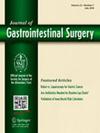可切除的胃癌:是否应根据微卫星状态采用量身定制的手术策略?
IF 2.2
3区 医学
Q3 GASTROENTEROLOGY & HEPATOLOGY
引用次数: 0
摘要
背景:微卫星不稳定性(MSI-H)是胃癌(GC)的一个小亚组,具有良好的预后和预测意义。本研究旨在调查MSI与MSS GC的局部区域结节受累、总生存期(OS)和无病生存期(DFS),以及分子亚型和组织学特征之间的相互作用与生存结果的关系:本研究纳入了2017年至2023年期间接受手术治疗或未接受化疗的72例GC患者。比较了LN阳性和阴性患者的临床病理特征、OS和DFS,并根据微卫星状态、治疗方法、分子谱、肿瘤细胞类型进行了分层:结果:MSI GC在年龄较大的患者中更为常见(79.0岁对70.2岁,P结论:MSI GC在年龄较大的患者中更为常见(79.0岁对70.2岁,P结论):与MSS肿瘤相比,MSI GC局部淋巴结受累的风险明显较低,OS和DFS较好。其次,治疗反应因 MSI 状态而异:MSI 肿瘤患者从前期手术干预中获益更多,而 MSS 患者,尤其是混合组织型患者,术前化疗可改善预后。这些结果主张采用一种考虑微卫星状态、劳伦分类以及患者临床状况的定制治疗方法。本文章由计算机程序翻译,如有差异,请以英文原文为准。
Resectable gastric cancer: should we apply a tailored surgical strategy according to microsatellite status?
Background
High microsatellite instability (MSI) represents a small subgroup of gastric cancer (GC) with favorable prognostic and predictive significance. This study aimed to investigate locoregional lymph node (LN) involvement, overall survival (OS), disease-free survival (DFS), and the interplay between molecular subtypes and histologic profiles regarding survival outcomes in MSI GC vs microsatellite stability (MSS) GC.
Methods
This study included 72 patients with GC who underwent surgery with or without chemotherapy from 2017 to 2023. Clinicopathologic characteristics, OS, and DFS were compared between LN-positive and LN-negative patients stratified by microsatellite status, treatments, molecular profiles, and tumor cell types.
Results
MSI GC was more common in older patients (79.0 vs 70.2 years; P <.001), more common in females (73.68% vs 43.32%; P =.023), and associated with intestinal-type histology (94.5% vs 49.0%; P =.002). Positive LN involvement and lymphovascular invasion (LVI) were lower in the MSI group than in the MSS group (positive LN: 2.73 vs 4.15, respectively; P =.366; LVI: 36.8% vs 64.5%, respectively; P =.039). Patients with MSI showed slightly better OS and DFS than those with MSS (OS: 84.20% vs 66.00%, respectively; P =.108; DFS: 84.62% vs 63.89%, respectively; P =.120). In addition, compared with patients with MSS GC, those with MSI GC had improved OS and DFS in the LN-positive group (OS: 72.7% vs 61.3%, respectively; P =.255; DFS: 75.0% vs 50.0%, respectively; P =.148) and LN-negative group (OS: 100.0% vs 85.7%, respectively; P =.149; DFS: 100.0% vs 85.7%, respectively; P =.376). In patients not receiving chemotherapy, the MSI/intestinal-type group had the highest OS and DFS (77.0% and 87.5%, respectively; P =.024), whereas the MSS/mixed-type group had the lowest OS and DFS (25.0% and 100.0%, respectively; P =.290). In patients receiving chemotherapy, the MSI/intestinal-type group had the highest OS and DFS (100.0% and 100.0%, respectively; P =.741), whereas the MSS/mixed-type group had the lowest OS and DFS (66.7% and 50.0%, respectively; P =.397).
Conclusion
First, patients with MSI GC have a significantly lower risk of locoregional LN involvement and better OS and DFS than those with MSS GC. Second, treatment responses differ based on MSI status: patients with MSI tumors benefit more from upfront surgical interventions, whereas those with MSS, particularly mixed histotypes, demonstrate improved outcomes with preoperative chemotherapy. These results advocate for a tailored therapeutic approach that considers microsatellite status, Lauren classification, and patient clinical conditions.
求助全文
通过发布文献求助,成功后即可免费获取论文全文。
去求助
来源期刊
CiteScore
5.50
自引率
3.10%
发文量
319
审稿时长
2 months
期刊介绍:
The Journal of Gastrointestinal Surgery is a scholarly, peer-reviewed journal that updates the surgeon on the latest developments in gastrointestinal surgery. The journal includes original articles on surgery of the digestive tract; gastrointestinal images; "How I Do It" articles, subject reviews, book reports, editorial columns, the SSAT Presidential Address, articles by a guest orator, symposia, letters, results of conferences and more. This is the official publication of the Society for Surgery of the Alimentary Tract. The journal functions as an outstanding forum for continuing education in surgery and diseases of the gastrointestinal tract.

 求助内容:
求助内容: 应助结果提醒方式:
应助结果提醒方式:


